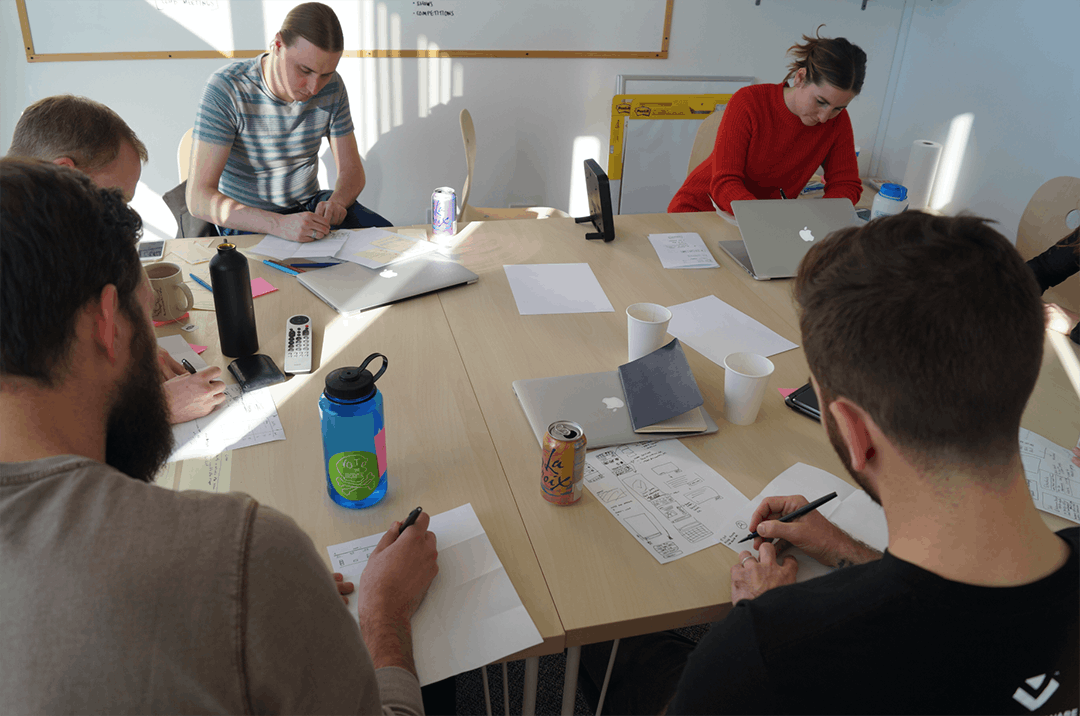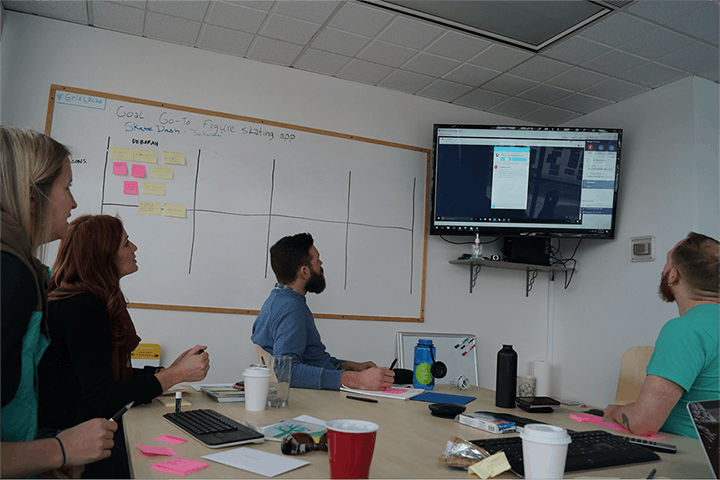The Design Sprint methodology was first created by Jake Knapp at Google Ventures. It’s a week-long process that he describes as a “greatest hits” of business strategy, innovation, behavioral science, design thinking, and more. A Design Sprint enables teams to focus by dedicating a full week to a single problem. Teams work together using structured exercises to create and validate design concepts and business decisions.
At Vynyl, we extend and adapt the Design Sprint methodology to fit each client’s product needs. Sometimes, instead of concentrating on a single problem, we use sprints as a way to align team members and focus on a strategy for product evolution. A cross-functional team of subject and product experts work together to bring clarity to abstract ideas. At the end of the Design Sprint, we have an informed prototype and a clear path for how to achieve the client’s vision.
What Does a Design Sprint Look Like

A typical Design Sprint has five stages, each lasting one day plus some pre-planning, but the methodology can adapt to different sprint schedules.
Pre-Sprint
A Design Sprint is most effective when it focuses on solving a well-defined, important problem. When defining the challenge, it’s key to consider the needs of two main groups: your company and your customers.
What are the business goals? The challenge you choose for the sprint week should be one the company is passionate about solving. Don’t worry if there are unknowns surrounding the problem. The sprint week will create a deep understanding of the problem and generate solutions.
It’s also critical to make sure that this challenge is actually a problem worth solving. That often means conducting enough research to understand the current state of the issue. Is this something users actually want? Can users solve this problem effectively in a different way already?
Pre-sprint planning exercises don’t need to involve the entire sprint team, but you should share any findings with the team before the sprint begins.
Speaking of the sprint team, assembling a dynamic group of people should be done before the sprint begins. The size of the group can vary but should include people with diverse expertise within your company. Choosing team members across departments allows you to gain insight into the many different perspectives of how your product or service currently works, and what needs refinement. Every team needs two leaders:
- The Decider: Ultimately decides which ideas are worth pursuing
- The Facilitator: Runs the Design Sprint and makes sure everyone follows the process
Teams should also include other experts from across your company. Consider (but don’t limit yourself to) the following disciplines:
- The tech expert
- The design expert
- The customer service expert
- The financial expert
- The marketing expert
Map
Stage one of the sprint week is all about understanding the problem. The pre-sprint work helped define the challenge, but mapping focuses on generating a shared understanding of the problem amongst the team and creating a path for the sprint week.
Everyone comes into the sprint with their own expertise about the product given their background and how and when in the product lifecycle they interact with it. Structured exercises -- such as goal-setting, expert interviews, and mapping the user journey -- help create a shared knowledge base and ensure we’re focusing our efforts in the right direction. Ultimately, stage one ends with a specific target to focus on for the rest of the sprint.
Sketch
Stage two is all about solutions. Now that the team has a deep understanding of the problem, it’s time to start coming up with innovative ways to solve it. To get the creative juices flowing, the day begins with lightning demos. Each member of the team will share inspiration or similar solutions from other products and industries.
When it comes to sketching, Design Sprints follow a “work together alone” approach. After a few rounds of guided brainstorming exercises, each person creates a solution sketch—an opinionated hypothesis on how to solve the challenge at hand. These sketches will be critiqued in silence by each individual on the sprint team so they need to be able to stand on their own without a sales pitch.
Once everyone has developed their solution sketch, they’re hung on the wall to revisit the next day.

Decide
In stage three the sprint team creates a clear, solid plan for the prototype. The sprint team critiques solution sketches and decides which ones have the best chance of achieving the team’s long-term goal and solving the sprint problem.
To avoid unnecessary cycles of discussion and debate, Design Sprints follow a structured critique and voting system to come to a decision. This typically includes a Heat Map, where team members identify interesting ideas, verbiage, or parts of each solution sketch. The next stage is a facilitated Speed Critique where each solution sketch is quickly discussed, and any additional ideas are captured. From there, the team chooses the solution sketch that has the most potential to accomplish the long-term goal.
Once a direction is chosen, the team creates a Storyboard—an expanded version of the solution sketch that becomes the blueprint for the prototype. The sprint team maps out the user journey so that the experience feels realistic during user testing.

Prototype
In stage four it’s time to bring the sketches to life as a prototype. We digitize the storyboard to emulate a finished product. At this stage, the team should be shooting for Goldilocks quality: good enough. Flesh out strategic screens and then design just enough to reflect what interacting with a real product will look and feel like. The goal during the prototype stage is to make the experience realistic enough to evoke honest reactions from users when you test it.
Validate
In the final stage of the sprint it’s time to validate the decisions made during the week. Conduct user tests and observe how real-world customers interact with the prototype. Clear patterns will emerge and it will become obvious which concepts the team nailed and which ideas may need to be refined. In general, this leads to one of three outcomes:
- Validated assumptions: The work that the sprint team produced was accurately aligned with users’ wants and needs. Now it’s time for development or to execute next steps.
- Flawed success: Users validated some hunches but not all of them. Now the team has the input needed to pivot in the right direction.
- Efficient failure: Good news! The company saved months of design, engineering, and development costs. Time to take a step back and refocus.

The Benefits of Design Sprints
Cost Effectiveness
Design Sprints bring immense value to our clients. In a typical development cycle, it takes months (and lots of money) to build out products and get them in the hands of users. With a Design Sprint, our clients learn from users in as few as five days. By quickly creating a realistic prototype we are able to see customers react to a product at a much lower cost. Clients save time and money without compromising intel.
Real-World Insights
Ideas are tested on real-world customers. The team gains valuable feedback from the ideal audience without allowing internal biases to sway decisions. The insights help to combat blind spots and inertia by providing the team with direct feedback from customers.
Aligned Team Members and Stakeholders
Design Sprints are all about collaboration. With teamwork, we define goals, highlight pain points, and create inspiring solutions. Over the course of the week a shared narrative forms. As team members share information and user feedback is revealed, everyone aligns on the vision and goals for the product.
Documentation
It’s best to get all the right people in the room during the sprint week, but that isn’t always possible. In addition to a realistic prototype, we provide a sprint report documenting all of the exercises from the week to share with team members, investors, or curious minds.
Final thoughts
At Vynyl, we’ve seen the value that Design Sprints can bring to an organization. In a short period of time, you can validate design concepts and business decisions that impact the people who use your products and services. The end result of the Design Sprint is an informed prototype and a clear path for how to achieve your vision.